Target Audience
This publication is a tool to aid turfgrass professionals, Extension specialists, and clientele in the identification and management of goosegrass in Florida turfgrasses.
Introduction
Like all turfgrass species used in Florida, goosegrass [Eleusine indica (L.) Gaertn.] is a warm-season species, making it one of the most difficult-to-control grassy weeds. Goosegrass is a very common and resilient weed with an ability to outcompete managed turfgrass ranging from golf course putting greens to home lawns (Figures 1 and 2), especially under poor conditions or heavy traffic and compacted soils. In Florida, goosegrass can survive year-round, resulting in mature plants at the onset of the season which reduce the efficacy of preemergence herbicides. Postemergence herbicide options are also limited; some exhibit reduced efficacy against mature goosegrass populations. Additionally, some herbicide-resistant goosegrass populations have already been confirmed.
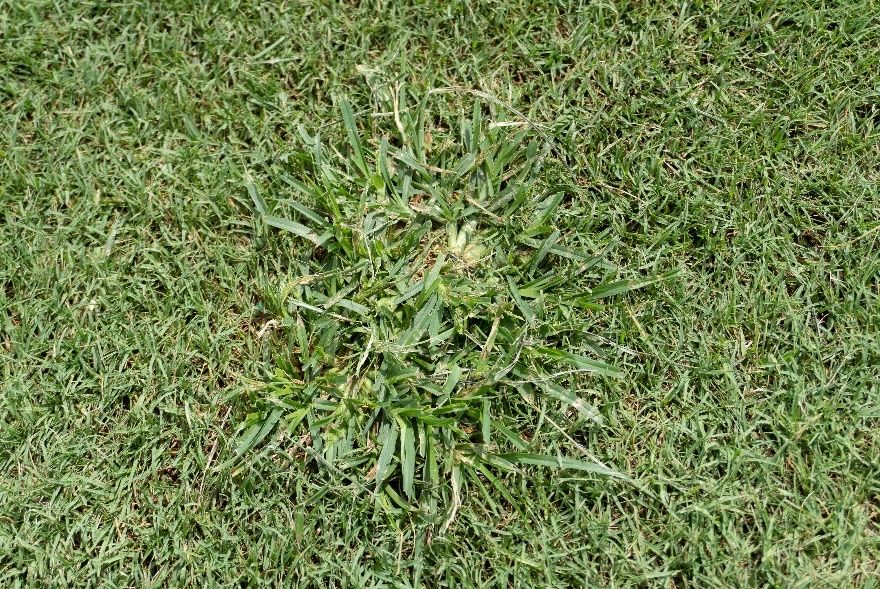
Credit: Pawel Petelewicz, UF/IFAS
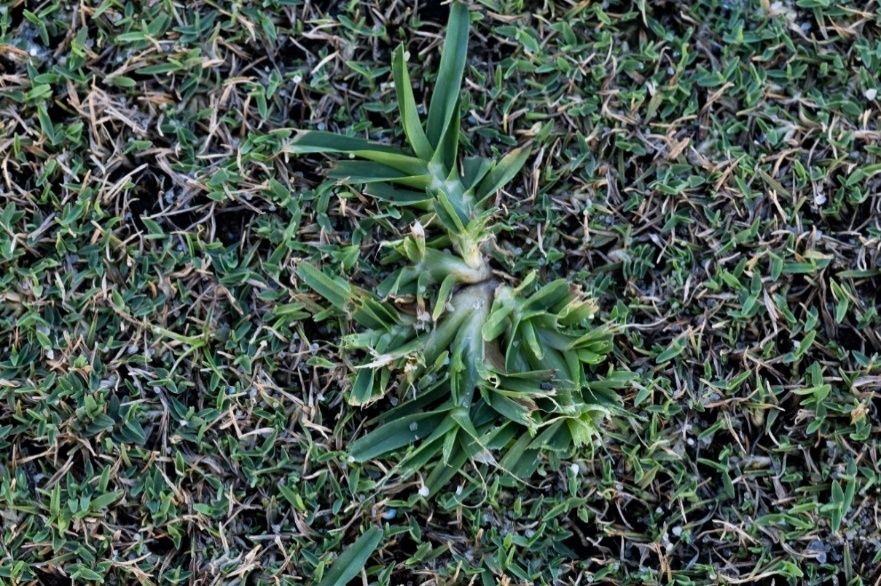
Credit: Pawel Petelewicz, UF/IFAS
Identification, Characteristics, and Biology
Goosegrass is considered native to Europe, Asia, and Africa, but is distributed globally in most warm-temperate, subtropical, and tropical areas. It is found in most of the United States and throughout Florida.
Goosegrass prefers full sun but can persist in partial shade conditions. It grows well in Florida soils, tolerating broad ranges of pH and moisture. Goosegrass is found in naturally disturbed areas and across all crop production systems. Importantly, goosegrass is considered an indicator of soil compaction and is problematic in turfgrass exposed to heavy vehicular or foot traffic (e.g., walk and cart pathways, athletic fields, golf putting greens, sidelines, etc.), resulting in reduced competition from the desired turf species. During summer months, it may easily outcompete turfgrass weakened from drought, shade, or pest activity.
Goosegrass is considered a summer annual, but in Florida’s tropical climates it often survives as a short-lived perennial. Reproduction occurs by seed, with an extremely high infestation capacity. Failure to control mature individuals will expand the seed bank and perpetuate the population. In Florida, germination can occur throughout the year under favorable conditions. Research on seed germination is highly inconsistent, with some reports suggesting soil temperatures need to reach 60°F–65°F, while others report fluctuating 95°F (day)/68°F (night) temperatures are needed for goosegrass germination in Hawaii (Nishimoto and McCarty 1997). A light requirement in addition to temperature has also been studied. Collectively, these imply considerable variability, suggesting the likely existence of Florida-specific ecotypes.
Once seed germination is initiated, emergence occurs in 7–14 days followed by rapid growth, especially during the warm summer months. Emerging goosegrass is identified by a single leaf (cotyledon), and seedlings are usually prostrate in growth habit, appearing slanted towards the soil (Figures 3 and 4). The production of side-shoots (tillers) occurs within the first few weeks of growth, after developing six or more leaves (Figure 5). Goosegrass has folded vernation and leaves (0.2–0.4 inch wide, usually up to 6 inches long) that appear folded with blunt tips and distinctly flattened stems (Figure 6). Mature leaves are generally smooth (hairless), although long sparse hairs can be present near the base of the leaf. The ligule is membranous and fringed (Figure 7). Goosegrass has no auricles, and the leaf sheath is flattened and split open, with overlapping and keeled margins (Figure 8).
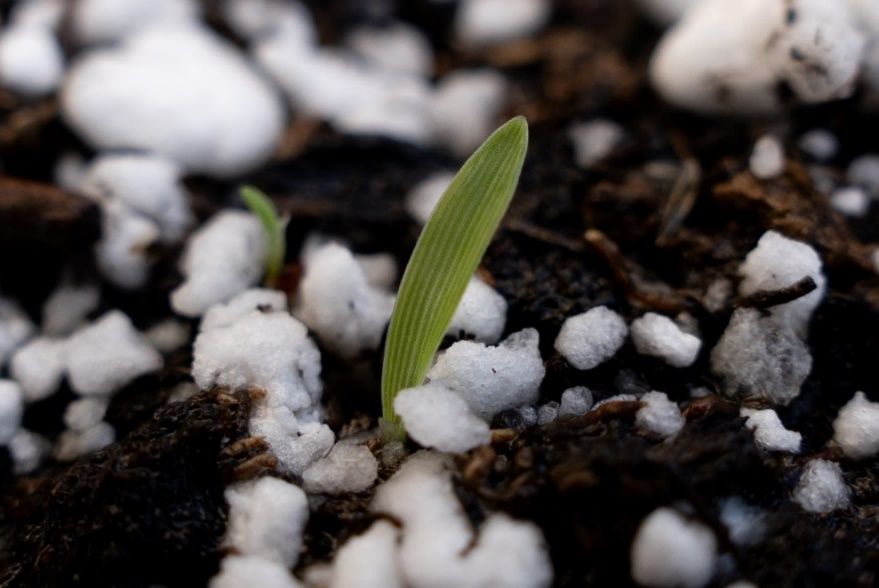
Credit: Pawel Petelewicz, UF/IFAS
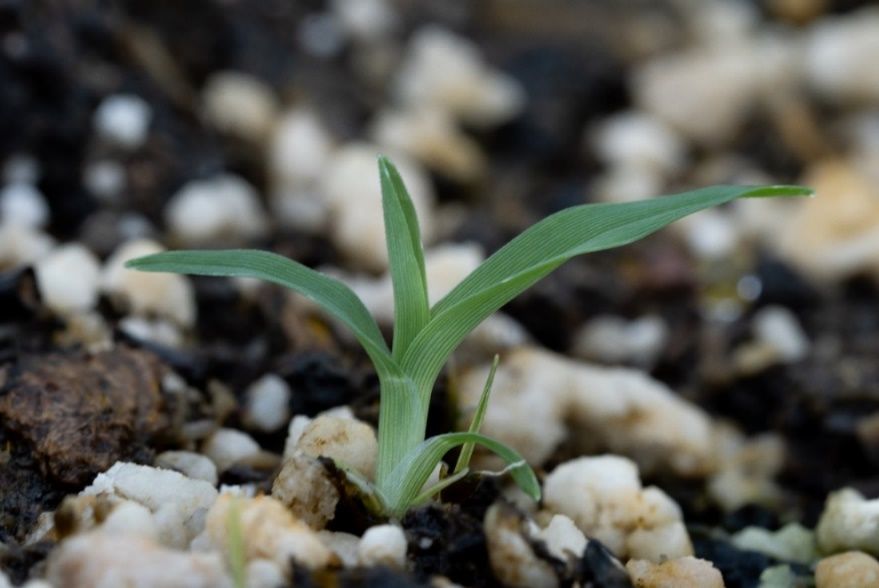
Credit: Pawel Petelewicz, UF/IFAS
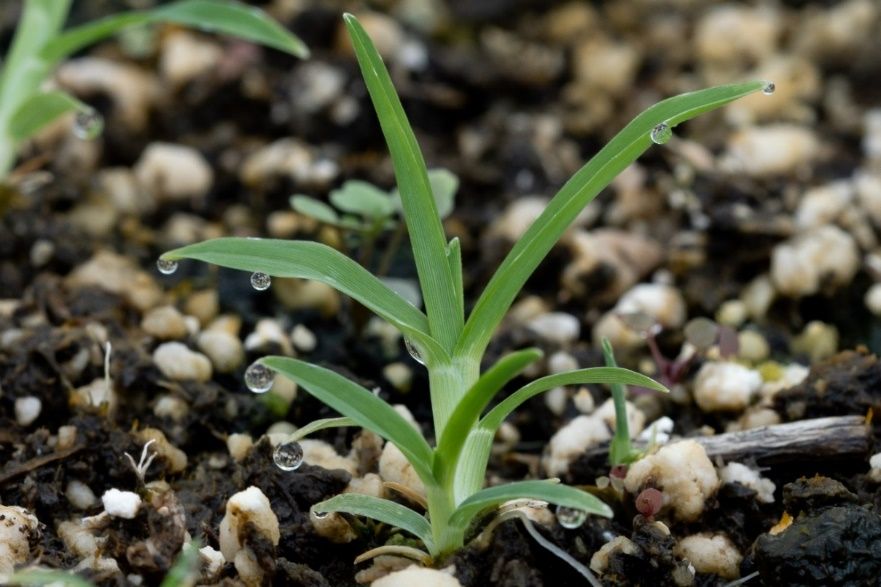
Credit: Pawel Petelewicz, UF/IFAS
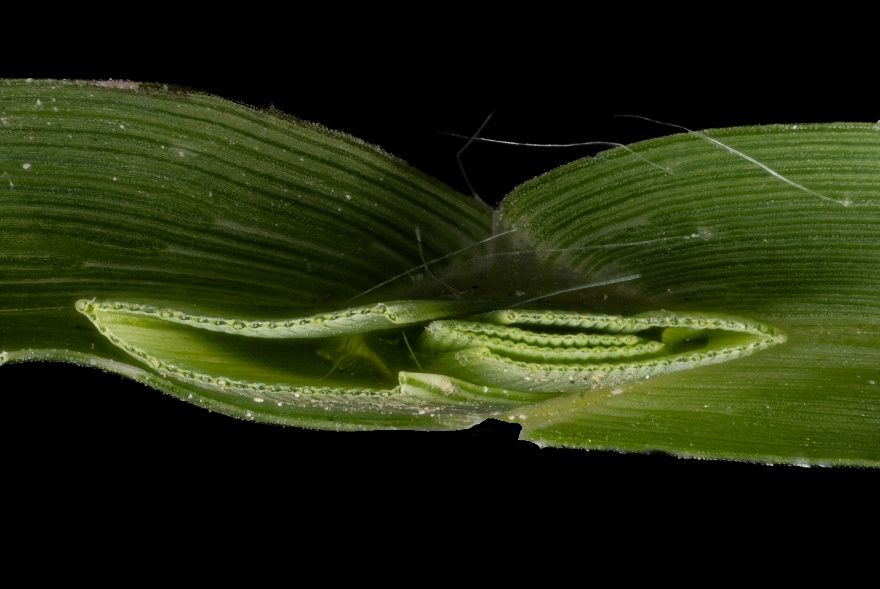
Credit: Pawel Petelewicz, UF/IFAS

Credit: Pawel Petelewicz, UF/IFAS

Credit: Pawel Petelewicz, UF/IFAS
Goosegrass flowers from spring to fall in central and north Florida and year-round in south Florida. Seedheads consist of a branched raceme, typically with 4–8 fingerlike branches (or racemes) radiating from the top of the flowering culm with 1 or 2 subtending racemes below the terminal cluster (Figure 9). These resemble a goose foot, thus giving the grass its common name. Each raceme contains zipper-like rows of individual floral spikelets (Figure 10). Seedheads can be formed under close mowing conditions (Figure 11). Seeds mature from the base of the raceme upwards and are encased within chaff-like glumes when shed from the seedhead (Figure 12). Individual plants can produce 50,000–140,000 seeds which are easily dispersed by wind, rain, animals, humans, and maintenance equipment. Seeds may remain viable in the soil for several years, but most germinate rapidly under optimal conditions.

Credit: Pawel Petelewicz, UF/IFAS
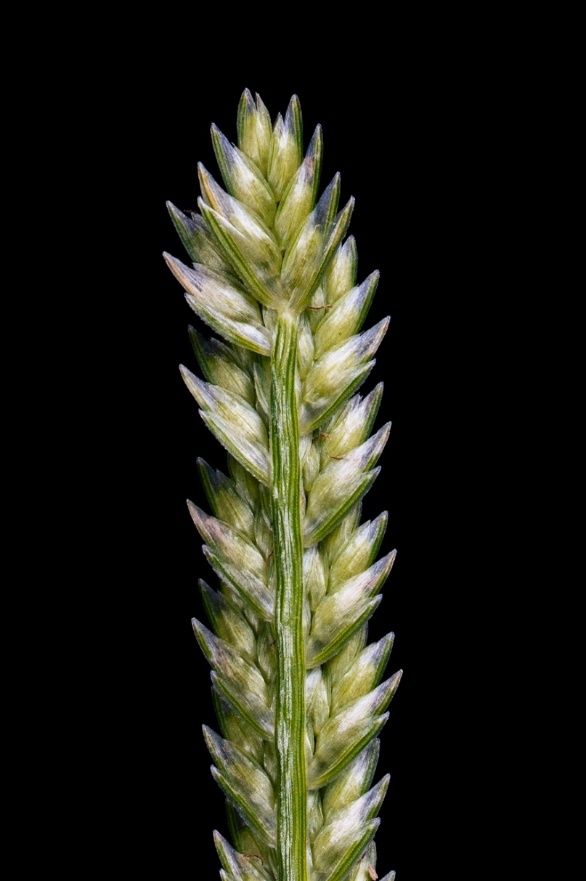
Credit: Pawel Petelewicz, UF/IFAS
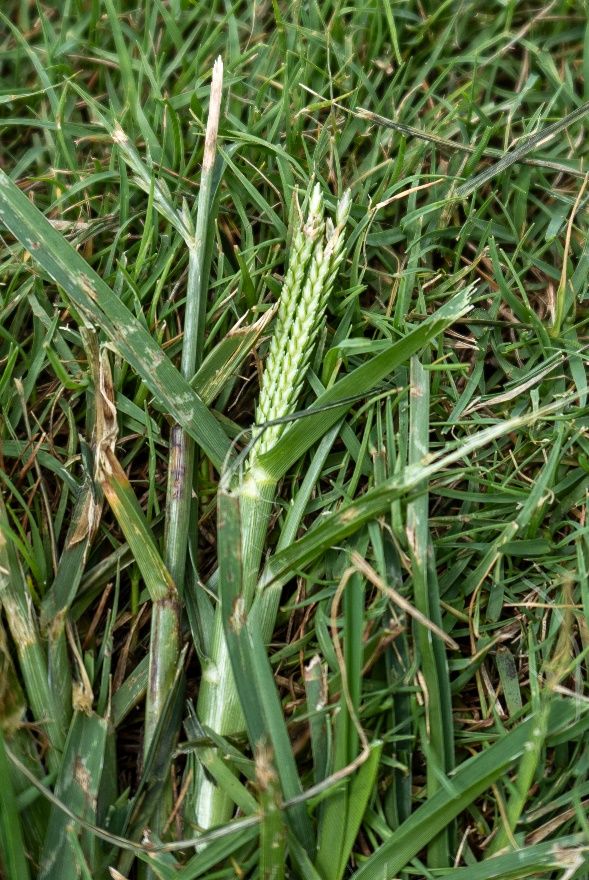
Credit: Pawel Petelewicz, UF/IFAS
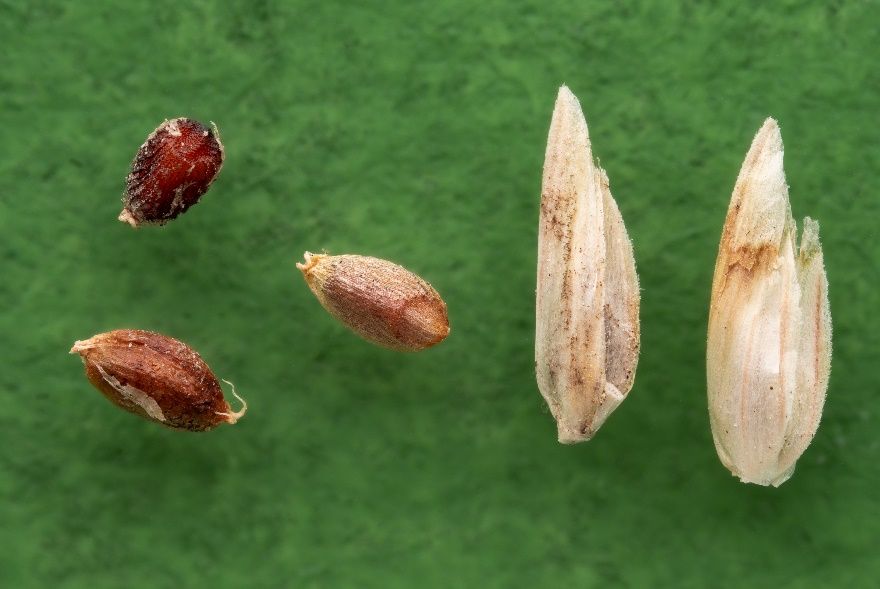
Credit: Pawel Petelewicz, UF/IFAS
The overall appearance of goosegrass in turf is unique compared to most other weedy grasses. It is a tough, clumping bunch of grass that grows nearly horizonal with radiating tillers and silvery/whitish leaf sheaths (Figure 13).

Credit: Pawel Petelewicz, UF/IFAS
Management in Florida Turfgrasses
Goosegrass is problematic in all major turfgrasses in Florida. These include St. Augustinegrass [Stenotaphrum secundatum (Walt.) Kuntze], zoysiagrasses (Zoysia spp.), centipedegrass [Eremochloa ophiuroides (Munro) Hack.], and bahiagrass (Paspalum notatum Flüggé). While the above are considered residential or utility turf, bermudagrass (Cynodon spp.) is managed primarily for Florida athletic fields and golf courses. Management strategies in this publication focus on goosegrass control options for the aforementioned turfgrasses.
Preventative Control
Because goosegrass is primarily spread through seeds, strategies to avoid seed dispersal into the turf area should be employed. These include cleaning equipment, using proper mowing to reduce seedhead development, and reducing traffic through areas where goosegrass is flowering. Another aspect of prevention concerns herbicide resistance, whereby an herbicide-resistant population is identified, quarantined, and potentially eradicated to avoid spread.
Cultural Control
Successful management of any weed occurring in turfgrass, but especially difficult-to-control species such as goosegrass, begins with sound turfgrass management, promoting a vigorous and healthy sward through optimal growing conditions. These include proper cultivar selection, fertility, irrigation/drainage, aeration, mowing height and frequency, and pest management. Practices focused on a dense canopy will deter germination and seedling establishment by preventing light from reaching the soil surface and lowering soil surface temperatures. In many situations where goosegrass is problematic, an underperforming turf with gaps and voids is the primary reason. Consult the “Additional Resources” section of this publication for comprehensive turfgrass and turf pest management guidelines for Florida.
Physical/Mechanical Control
In cases of light infestation (isolated populations or insignificant escapes), individual goosegrass plants can be controlled manually by removing the crown (i.e., the basal growing point). Unlike many stoloniferous or rhizomatous grasses, goosegrass does not have the ability to regrow once the central crown is removed. A pocketknife will typically work for mechanical removal, but larger plants may require a larger tool (e.g., shovel or machete). The roots must be severed to effectively remove the crown.
Chemical Control
As part of an integrated strategy, herbicides are often used to provide goosegrass control. Herbicide options for goosegrass control are limited; preemergence applications are considered to be the essential approach, followed by early postemergence applications as needed. Control of mature populations is increasingly difficult. Relying solely on herbicides is not recommended because goosegrass is a highly adaptable species and is prone to developing resistance to herbicides. This includes resistance to glyphosate, diclofop, prodiamine, metribuzin, and oxadiazon. Moreover, reports of reduced foramsulfuron efficacy have become increasingly frequent. Herbicides for goosegrass control discussed in this publication are listed with their mode-of-action grouping from the Weed Science Society of America to inform readers and encourage herbicide rotation (i.e., using herbicides with different groupings). Emphasis should be placed on an integrated, programmatic approach utilizing all methods for control.
Before selecting and applying an herbicide, it is important to integrate resistance management strategies that include mode-of-action (MOA) rotation, tank-mixing, and non-chemical control methods. These can be found in Ask IFAS publication SS-AGR-394, “Turfgrass Herbicides: Mode of Action and Resistance Management” (https://edis.ifas.ufl.edu/AG398). Application methods can also influence control, especially for preemergence herbicides. Liquid spray application provides superior coverage and distribution uniformity, which gains significance as the turf canopy becomes thinner. However, spray applications often call for more complex application equipment, which cannot always be utilized in small-scale settings. Conversely, granular applications are often more convenient (e.g., they allow for mixing with fertilizers for professional use) and can be executed with simple rotary spreaders. Drawbacks of granular applications include greater risk of misapplication due to improper operation, calibration, or inadequate overlap. In some cases, smaller-diameter granules can improve performance. Nevertheless, such applications are less likely to alarm the public by smell or sight compared to boom spraying. Additional considerations are the types and numbers of herbicide products accessible to homeowners (e.g., via retailers carrying gardening supplies) compared to professional-grade (including restricted use) products for industry professionals. For more information on this topic, consult Ask IFAS publication ENH1311, “Florida Homeowner Herbicide Guide: Considerations, Application, and Selection” (https://edis.ifas.ufl.edu/EP575).
Preemergence Herbicides
Preemergence herbicides are the foundation for weed control in Florida turfgrasses. They are generally applied to the turf and watered to come in contact with the soil surface. They should be in place prior to goosegrass germination to kill seedlings as they germinate. If goosegrass seedlings have emerged, even if plants are small and difficult to see, preemergence herbicides have little to no effect. Therefore, proper application timing is critical for successful preemergence control.
There are multiple approaches to scheduling preemergence applications. The most straightforward is a calendar-based approach where preemergence herbicide applications are typically scheduled for the week of (or a week before) March 1, March 15, and April 1 in south, central, and northern Florida, respectively. However, due to fluctuating annual weather patterns, the calendar-based system has become less accurate, leading to weed escapes. Another recommendation is to use natural, phenological indicators such as blooming of landscape plants like azaleas and dogwoods as the reference point for triggering preemergence applications. Since goosegrass typically germinates later than some other summer annual grasses, preemergence applications should be scheduled 3–4 weeks after these flowering events. However, this is only applicable in the northern parts of Florida where these flowering ornamentals are planted. Additionally, some azalea varieties may flower year-round, making this indicator considerably less reliable. Soil temperature is often the most accurate germination indicator, where most sources recommend initiating preemergence application when soil temperatures reach 60°F for 24 consecutive hours. By far, the most precise predictor for goosegrass emergence in turfgrass settings is the growing degree day (GDD) model with a base temperature of 10°C developed for the northern United States. It should be noted that currently, there is no reliable GDD-based model developed for predicting emergence of goosegrass in Florida conditions. Such models are not easily adapted to the subtropical and tropical climates and require considerations accounting for GDD inflation due to high temperatures. Additional challenges may result from potential goosegrass requirement for fluctuating temperatures and regional variability between ecotypes. Additionally, neither of the temperature-based approaches accounts for factors such as light/photoperiod, dormancy, osmotic potential, etc., which may also impact goosegrass emergence.
It is important to understand preemergence herbicides require moderate irrigation or rainfall within 2 days of application for optimal efficacy to wash the herbicide from the foliage to the soil, ensuring direct herbicide contact with the germinating seeds and emerging seedlings. The amount of water should be around 0.5 inches; excessive water may push herbicides below the layer of soil in which germination occurs, reducing weed control.
Stand-alone homeowner-grade preemergence herbicide options are limited to dithiopyr-, pendimethalin-, and prodiamine-based products (Table 1). “Weed-and-feed” (i.e., herbicide/fertilizer pre-blend) products have limited activity on goosegrass, as the timing of fertilization and weed control does not match goosegrass germination. In general, they are also not recommended for use by Florida homeowners. For more detailed explanations, consult Ask IFAS publication ENH884, “Weed Management Guide for Florida Lawns” (https://edis.ifas.ufl.edu/EP141).
Herbicides for preemergence control of goosegrass for use by turfgrass professionals are summarized in Table 2 and include dithiopyr, pendimethalin, prodiamine, bensulide, flumioxazin (in dormant bermudagrass only), oxadiazon, S-metolachlor, and indaziflam. Among these, indaziflam and oxadiazon are most efficacious against goosegrass, but some level of damage might occur when these herbicides are applied to certain turf. The use of preemergence herbicides in putting greens is further limited — currently, only bensulide and bensulide + oxadiazon can be utilized, and bensulide + oxadiazon can only be used in bermudagrass.
For persistent goosegrass control, most of these herbicides will require sequential reapplications. The time interval between treatments depends on environmental conditions, herbicide half-life, and rates, but is specified by the product label with typical intervals ranging between 5 and 12 weeks. In tropical climates such as Florida, some professional settings (e.g., golf courses, athletic fields) may call for as many as 5 applications per year. In areas where turf is to be established (including sod and winter overseeded areas), most preemergence herbicides should be ceased about 2 to 4 months prior to planting/seeding to avoid root damage and/or reduced germination.
Postemergence Herbicides
Postemergence herbicides are applied to goosegrass plants which have already emerged and are actively growing within the turf. Postemergence herbicides should be used to supplement preemergence applications, not as the primary means of control. However, preemergence applications rarely result in complete control; therefore, postemergence herbicides are an important component of a management program.
Only two products are available for typical homeowner use. Both contain sulfentrazone herbicide, which provides postemergence efficacy against goosegrass (Table 1). However, efficacy declines as goosegrass matures and begins to tiller. The only alternatives are spot applications of non-selective herbicides or physical removal of plants. Applications of non-selective herbicides must be performed carefully and limited only to the target plant because they will result in damage of the desired turf (or other plants). For more information on non-selective options for homeowners, consult Ask IFAS publication ENH1311, “Florida Homeowner Herbicide Guide: Considerations, Applications, and Selection” (https://edis.ifas.ufl.edu/EP575).
Table 3 lists postemergence herbicides for goosegrass control by turf professionals. These include fenoxaprop, foramsulfuron, metribuzin, simazine (simazine use is restricted during summer months), sulfentrazone, asulam (St. Augustinegrass and ‘Tifway 419’ bermudagrass sod farms only), mesotrione, and topramezone. Pre-mixes that include one or more of the products listed previously will provide control if the adequate rates are allowed; they also may provide preemergence control depending on other additives. The four-way mixture formulated as SpeedZone EW (2,4-D + MCPP + dicamba + carfentrazone), while primarily targeting broadleaves, has been reported to provide satisfactory goosegrass control.
Special labels or recommendations are also available for Florida that allow additional uses of certain herbicides in specific settings. These include a Section 2(ee) Recommendations for Recognition (specific trifloxysulfuron and proprietary safener pre-mix) and Fusilade II T&O (fluazifop) tank-mixes for goosegrass control in St. Augustinegrass and zoysiagrasses. A Section 24(c) Special Local Need Label allows tank-mixing Tenacity (mesotrione) with Princep Liquid (simazine) and with or without Pennant Magnum (S-metolachlor) for applications in bermudagrass (certain cultivars only) athletic fields and golf courses, with the exception of putting greens.
There are limited selective postemergence options available for controlling goosegrass in putting greens. Currently, only foramsulfuron can be legally used in bermudagrass putting surfaces. SpeedZone EW neither allows nor restricts such use; however, if damage to turf occurs, the liability lies with the applicator.
Adequate soil moisture at the time of herbicide application is required for optimal postemergence control (critical for use of foramsulfuron). When turfgrass is managed on sandy soils and/or when the turf surface is kept drier for optimal playing conditions, increasing volumetric soil moisture content (VMC) may prevent herbicide failure. Portable moisture meters are helpful to determine if the soil conditions are appropriate (>12% VMC). Research also shows that conditions of high evaporative demand such as low humidity and high temperature improve the efficacy of foramsulfuron; therefore, modifications on application timings to meet such requirements may improve goosegrass control.
Control of goosegrass with postemergence herbicides becomes increasingly challenging when plants are allowed to mature, produce tillers, and/or develop seedheads. Some of the aforementioned herbicides (e.g., foramsulfuron, sulfentrazone) may exhibit reduced efficacy in such cases. Early postemergence applications to young seedlings should be prioritized whenever possible, and tank-mixes of multiple MOAs usually improve efficacy against goosegrass. Of these, metribuzin and topramezone have been shown to eradicate well-established and mature goosegrass populations. While none of the current goosegrass herbicides guarantee complete safety to turf, of particular concern is some injury potential from metribuzin as well as topramezone- and mesotrione-caused foliar bleaching in bermudagrass which may occur for 2–4 weeks.
Research shows that combining topramezone with metribuzin may lead to enhanced performance or enable the reduction of effective rates. The addition of metribuzin may also reduce or alleviate foliar bleaching due to reductions in clipping volume. Other topramezone-safening strategies include tank-mixes with SpeedZone EW, chelated iron and/or ferrous sulfate additions, and immediate irrigation with approximately 0.25 inches of water following the herbicide application (a.k.a. “watering-in” treatment). Such irrigation treatment may significantly reduce injury from metribuzin, topramezone, and their tank-mixes, but also from other herbicides such as simazine, mesotrione, and/or pre-mix formulated as SpeedZone EW. However, the time interval between herbicide application and irrigation remains critical, the degree of safening may vary depending on multiple factors, and the herbicidal efficacy against goosegrass may be impacted.
Additional Resources
For a comprehensive summary of professional-grade herbicides for use in turfgrass and information on proper resistance management practices, consult Ask IFAS publication SS-AGR-394, “Turfgrass Herbicides: Mode of Action and Resistance Management” (https://edis.ifas.ufl.edu/AG398).
For additional information and guidance on proper management practices and control strategies for weeds in turfgrass and landscape, consult Ask IFAS publication ENH884, “Weed Management Guide for Florida Lawns” (https://edis.ifas.ufl.edu/EP141), Ask IFAS publication ENH1262, “Improving Weed Control in Landscape Planting Beds” (https://edis.ifas.ufl.edu/EP523), Ask IFAS publication ENH1311, “Florida Homeowner Herbicide Guide: Considerations, Applications, and Selection” (https://edis.ifas.ufl.edu/EP575), and/or Ask IFAS publication ENH95, “Postemergent Herbicides for Use in Ornamentals” (https://edis.ifas.ufl.edu/WG059).
To protect your lawn from other pests, consult Ask IFAS publication SSPLP14, “Turfgrass Disease Management” (https://edis.ifas.ufl.edu/LH040), Ask IFAS publication PP-233, “Homeowner’s Guide to Fungicides for Lawn and Landscape Disease Management” (https://edis.ifas.ufl.edu/PP154), and Ask IFAS publication ENY-006, “Nematode Management in Residential Lawns” (https://edis.ifas.ufl.edu/NG039)
To keep your lawn healthy, always follow UF/IFAS recommendations. For comprehensive guidelines on proper management practices for particular turfgrass species, consult Ask IFAS publication ENH6, “Bahiagrass for Florida Lawns” (https://edis.ifas.ufl.edu/LH006), Ask IFAS publication ENH19, “Bermudagrass for Florida Lawns” (https://edis.ifas.ufl.edu/LH007), Ask IFAS publication ENH8, “Centipedegrass for Florida Lawns” (https://edis.ifas.ufl.edu/LH009), Ask IFAS publication ENH5, “St. Augustinegrass for Florida Lawns” (https://edis.ifas.ufl.edu/LH010), or Ask IFAS publication ENH11, “Zoysiagrass for Florida Lawns” (https://edis.ifas.ufl.edu/LH011).
For additional resources on proper turfgrass management practices, consult Ask IFAS publication ENH979, “Homeowner Best Management Practices for the Home Lawn” (https://edis.ifas.ufl.edu/EP236), Ask IFAS publication ENH10, “Mowing Your Florida Lawn” (https://edis.ifas.ufl.edu/LH028), Ask IFAS publication ENH9, “Watering Your Florida Lawn” (https://edis.ifas.ufl.edu/LH025), Ask IFAS publication ENH160, “Fertilization and Irrigation Needs For Florida Lawns and Landscapes” (https://edis.ifas.ufl.edu/EP110), Ask IFAS publication ENH1089, “Urban Turf Fertilizer Rule For Home Lawn Fertilization” (https://edis.ifas.ufl.edu/EP353), Ask IFAS publication ENH1287, “Iron for Florida Turfgrasses” (https://edis.ifas.ufl.edu/EP551), or Ask IFAS publication ENH 02, “Preparing to Plant a Florida Lawn” (https://edis.ifas.ufl.edu/LH012).
Notes
Mention of a commercial or herbicide brand name or chemical does not constitute a recommendation or warranty of the product by the authors or UF/IFAS, nor does it imply approval of the product to the exclusion of other products that may also be suitable. Products should be used according to label instructions and safety equipment required on the label and by federal or state law should be employed. Pesticide registrations may change, so it is the responsibility of the user to ascertain if a pesticide is registered by the appropriate state and federal agencies for its intended use.
The use of trade names in this publication is solely for the purpose of providing specific information. UF/IFAS does not guarantee or warranty the products named, and references to them in this publication do not signify our approval to the exclusion of other products of suitable composition. Use pesticides safely. Read and follow directions on the manufacturer's label.
References
Arrieta, C., P. Busey, and S. H. Daroub. 2009. “Goosegrass and Bermudagrass Competition Under Compaction.” Agronomy Journal 101:11–16. https://doi.org/10.2134/agronj2007.0282
Boyd, A. P., J. S. McElroy, J. D. McCurdy, and P. E. McCullough. 2021. “Reducing Topramezone Injury to Bermudagrass Utilizing Chelated Iron and Other Additives.” Weed Technology 35:289–296. https://doi.org/10.1017/wet.2020.110
Brewer, J. R., and S. D. Askew. 2021. “Investigating Low-Dose Herbicide Programs for Goosegrass (Eleusine indica) and Smooth Crabgrass (Digitaria ischaemum) Control on Creeping Bentgrass Greens.” Weed Technology 35:604–610. https://doi.org/10.1017/wet.2021.55
Brewer, J. R., W. L. B. Askew, and S. D. Askew. 2022a. “Differences in Selectivity Between Bermudagrass and Goosegrass (Eleusine indica) to Low-Rate Topramezone and Metribuzin Combinations.” Weed Science 70:55–63. https://doi.org/10.1017/wsc.2021.52
Brewer, J. R., J. C. Craft, and S. D. Askew. 2022b. “Influence of Posttreatment Irrigation Timings and Herbicide Placement on Bermudagrass and Goosegrass (Eleusine indica) Response to Low-Dose Topramezone and Metribuzin Programs.” Weed Science 70:235–242. https://doi.org/10.1017/wsc.2021.80
Carroll, D. E., J. T. Brosnan, and G. K. Breeden. 2021. “Applications of Topramezone and SpeedZone® for POST Goosegrass (Eleusine indica) Control in Hybrid Bermudagrass.” Weed Technology 35:598–603. https://doi.org/10.1017/wet.2021.24
Elmore, M. T., M. Prorock, and D. P. Tuck. 2020. A Model to Predict Goosegrass (Eleusine indica) Seedling Emergence in Cool-Season Turfgrass [Poster presentation]. 2020 ASA, CSSA, and SSSA International Annual Meetings, Phoenix, AZ.
EPA. 2023a. “FIFRA Section 2(ee) Recommendation. Label Code: AL1658185AC0523.” U.S. Environmental Protection Agency. https://www.cdms.net/ldat/ldIOE003.pdf
EPA. 2023b. “FIFRA Section 2(ee) Recommendation. Label Code: AL1658183AC0722.” U.S. Environmental Protection Agency. https://www.cdms.net/ldat/ldIOE005.pdf
EPA. 2023c. “FIFRA Section 24(c) Special Local Need Label. EPA SLN No. FL-140010. Label Code: FL1267069BA0516.” U.S. Environmental Protection Agency. https://www.cdms.net/ldat/ld8D9002.pdf
Kerr, R. A., L. B. McCarty, W. C. Bridges, and M. Cutulle. 2019a. “Key Morphological Events Following Late-Season Goosegrass (Eleusine indica) Germination.” Weed Technology 33:196–201. https://doi.org/10.1017/wet.2018.93
Kerr, R. A., L. B. McCarty, P. J. Brown, J. Harris, and J. S. McElroy. 2019b. “Immediate irrigation improves turfgrass safety to postemergence herbicides.” HortScience 54:353–356. https://doi.org/10.21273/HORTSCI13571-18
Ma, X., Y. Ma, H. Wu, X. Ren, W. Jiang, and Y. Ma. 2019. “Emergence timing affects growth and reproduction of goosegrass (Eleusine indica).” Weed Technology 33:833–839. https://doi.org/10.1017/wet.2019.61
Nishimoto, R. K., and L. B. McCarty. 1997. “Fluctuating temperature and light influence seed germination of goosegrass (Eleusine indica).” Weed Science 45:426–429.
Petelewicz, P., P. H. McLoughlin, K. E. Williams, and M. Schiavon. 2023. “Study Synopsis: Evaluation of Herbicides for Postemergent Control of Goosegrass in Bermudagrass Turf.” Florida Turf Digest 41 (4): 14–17. https://cdn.ymaws.com/www.ftga.org/resource/resmgr/turf_digest/2023/ftd_2023_summer.pdf
Sharpe, S., and N. S. Boyd. 2019. “Germination Ecology for Florida Populations of Carpetweed (Mollugo verticillata), Carolina Geranium (Geranium carolinianum), Eclipta (Eclipta prostrata), and Goosegrass (Eleusine indica).” Weed Science 67 (4): 433–440. https://doi.org/10.1017/wsc.2019.17
Shekoofa, A., J. T. Brosnan, J. J. Vargas, D. P. Tuck, and M. T. Elmore. 2020. “Environmental Effects on Efficacy of Herbicides for Postemergence Goosegrass (Eleusine indica) Control.” Scientific Reports 10:20579. https://doi.org/10.1038/s41598-020-77570-5
USDA NRCS. 2014. “USDA Plants Database: Eleusine indica (L.) Gaertn.” United States Department of Agriculture, Natural Resources Conservation Service. https://plants.usda.gov/home/plantProfile?symbol=ELIN3
Yelverton, F. 2017. “Goosegrass.” TurfFiles. NC State Extension. https://content.ces.ncsu.edu/goosegrass
Table 1. Herbicide options available for homeowners for the selective control or suppression of goosegrass (Eleusine indica) in most prevalent Florida turfgrasses.
Table 2. Professional-grade preemergence herbicide options for the selective control or suppression of goosegrass (Eleusine indica) in most prevalent Florida turfgrasses.
Table 3. Professional-grade postemergence herbicide options for the selective control or suppression of goosegrass (Eleusine indica) in most prevalent Florida turfgrasses.